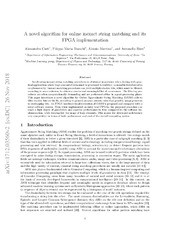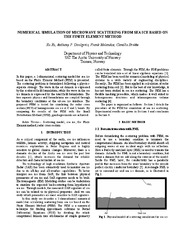Blar i tittel Artikler, rapporter og annet (fysikk og teknologi)
Viser treff 563-582 av 942
-
Non-trace full-F gyro-fluid interchange impurity advection
(Journal article; Tidsskriftartikkel; Peer reviewed, 2023-03-01)A full-F isothermal gyro-fluid model and code (which is based on the full distribution function F compared to only small fluctuations) is extended to handle self-consistent coupling of multiple quasi-neutral ion species via the polarisation equation in the long wavelength approximation. The numerical model is used to determine two-dimensional interchange driven ‘blob’ transport in a plasma with ... -
Non-triggered auroral substorms and long-period (1–4 mHz) geomagnetic and auroral luminosity pulsations in the polar cap
(Journal article; Tidsskriftartikkel; Peer reviewed, 2017-03-08)A study is undertaken into parameters of the polar auroral and geomagnetic pulsations in the frequency range 1– 4 mHz (Pc5/Pi3) during quiet geomagnetic intervals preceding auroral substorms and non-substorm background variations. Special attention is paid to substorms that occur under parameters of the interplanetary magnetic field (IMF) conditions typical for undisturbed days (“non-triggered ... -
Nonlocal damage mechanics for quantification of health for piezoelectric sensor
(Journal article; Tidsskriftartikkel; Peer reviewed, 2018-09-18)In this paper, a novel method to quantify the incubation of damage on piezoelectric crystal is presented. An intrinsic length scale parameter obtained from nonlocal field theory is used as a novel measure for quantification of damage precursor. Features such as amplitude decay, attenuation, frequency shifts and higher harmonics of guided waves are commonly-used damage features. Quantification of the ... -
Nordlys i verdensrommet
(Journal article; Tidsskriftartikkel, 1980)Vi vil ikke her gå inn i nordlyset som vi kjenner det fra jorden, men kort omtale andre steder i verdensrommet hvor vi har observert nordlyslignende fenomen eller hvor vi kan vente å finne beslektede fenomen. -
Nordlysobservatoriet i dag
(Journal article; Tidsskriftartikkel, 1980)Da Det Norske Institutt for Kosmisk Fysikk ble del av Universitetet i Tromsø, opphørte Nordlysobservatoriet å eksistere som en formell enhet. Det som i dag omfattes av Nordlysobservatoriet, er dels en fortsettelse av den opprinnelige observasjonsvirksomheten til det gamle Nordlysobservatoriet - men også nye aktiviteter har kommet til - særlig innen feltene plasmafysikk og radiogeofysikk. I det ... -
Nordområdeprosjektet EISCAT
(Chronicle; Kronikk, 2011) -
A Novel Algorithm for Online Inexact String Matching and its FPGA Implementation
(Journal article; Tidsskriftartikkel; Peer reviewed, 2019-05-14)Among the basic cognitive skills of the biological brain in humans and other mammals, a fundamental one is the ability to recognize inexact patterns in a sequence of objects or events. Accelerating inexact string matching procedures is of utmost importance when dealing with practical applications where huge amounts of data must be processed in real time, as usual in bioinformatics or cybersecurity. ... -
A novel code for numerical 3-D MHD studies of CME expansion
(Journal article; Tidsskriftartikkel; Peer reviewed, 2009) -
A Novel Rayleigh Dynamical Model for Remote Sensing Data Interpretation
(Journal article; Tidsskriftartikkel; Peer reviewed, 2020-02-19)This article introduces the Rayleigh autoregressive moving average (RARMA) model, which is useful to interpret multiple different sets of remotely sensed data, from wind measurements to multitemporal synthetic aperture radar (SAR) sequences. The RARMA model is indeed suitable for continuous, asymmetric, and nonnegative signals observed over time. It describes the mean of Rayleigh-distributed ... -
Novel specular meteor radar systems using coherent MIMO techniques to study the mesosphere and lower thermosphere
(Journal article; Tidsskriftartikkel; Peer reviewed, 2019-04-05)Typical specular meteor radars (SMRs) use one transmitting antenna and at least a five-antenna interferometric configuration on reception to study the mesosphere and lower thermosphere (MLT) region. The interferometric configuration allows the measurement of the angle-of-arrival (AOA) of the detected meteor echoes, which in turn is needed to derive atmospheric parameters (e.g., mean winds, momentum ... -
Numerical Analysis of Microwave Scattering from Layered Sea Ice Based on the Finite Element Method
(Journal article; Tidsskriftartikkel; Peer reviewed, 2018-08-21)A two-dimensional scattering model based on the Finite Element Method (FEM) is built for simulating the microwave scattering of sea ice, which is a layered medium. The scattering problem solved by the FEM is formulated following a total- and scattered-field decomposition strategy. The model set-up is first validated with good agreements by comparing the results of the FEM with those of the small ... -
Numerical and experimental evaluation of high-frequency unfocused polymer transducer arrays
(Journal article; Tidsskriftartikkel; Peer reviewed, 2018-06-12)High-frequency unfocused polymer array transducers are developed using an adhesive-free layer-by-layer assembly method. The current paper focuses on experimental and numerical methods for measuring the acoustic performance of these types of array transducers. Two different types of numerical approaches were used to simulate the transducer performance, including a finite element method (FEM) study ... -
Numerical Simulation of Microwave Scattering from Sea Ice Based on The Finite Element Method
(Journal article; Tidsskriftartikkel; Peer reviewed, 2016-11-03)In this paper, a 2-dimensional scattering model for sea ice based on the Finite Element Method (FEM) is presented. The scattering problem is formulated following a physics-separate strategy. The wave in the air domain is expressed by the scattered field formulation, while the wave in the sea ice domain is expressed by the total field formulation. The two separate physics and formulations are coupled ... -
Numerical Solution of the Parametric Diffusion Equation by Deep Neural Networks
(Journal article; Tidsskriftartikkel; Peer reviewed, 2021-06-05)We perform a comprehensive numerical study of the effect of approximation-theoretical results for neural networks on practical learning problems in the context of numerical analysis. As the underlying model, we study the machine-learning-based solution of parametric partial differential equations. Here, approximation theory for fully-connected neural networks predicts that the performance of the ... -
Object detection neural network improves Fourier ptychography reconstruction
(Journal article; Tidsskriftartikkel; Peer reviewed, 2020-11-23)High resolution microscopy is heavily dependent on superb optical elements and superresolution microscopy even more so. Correcting unavoidable optical aberrations during post-processing is an elegant method to reduce the optical system’s complexity. A prime method that promises superresolution, aberration correction, and quantitative phase imaging is Fourier ptychography. This microscopy technique ... -
Object-based detection of linear kinematic features in sea ice
(Journal article; Tidsskriftartikkel; Peer reviewed, 2017-05-18)Inhomogenities in the sea ice motion field cause deformation zones, such as leads, cracks and pressure ridges. Due to their long and often narrow shape, those structures are referred to as Linear Kinematic Features (LKFs). In this paper we specifically address the identification and characterization of variations and discontinuities in the spatial distribution of the total deformation, which ... -
An objective global climatology of polar lows based on reanalysis data
(Journal article; Tidsskriftartikkel; Peer reviewed, 2018-04-16)Here we present an objective global climatology of polar lows. In order to obtain objective detection criteria, the efficacy of several parameters for separating polar lows from other cyclones has been compared. The comparison and the climatology are based on the ERA‐Interim reanalysis from 1979 ‐ 2016 and the high‐resolution Arctic System Reanalysis from 2000 ‐ 2012. The most effective parameters ... -
Observation of mesospheric dust and ionospheric conditions during the G-chaser rocket campaign
(Journal article; Tidsskriftartikkel; Peer reviewed, 2019-10)SPID, Smoke Particle Impact Detector, is a Faraday cup detector designed to measure nanometer-sized meteoric smoke particles during rocket flights. We report measurements made with SPID during the G-Chaser student rocket campaign 13 January 2019 and describe the design of the SPID instruments. Model calculations of dust trajectories within the detector result in an effective crosssection of 0.97 for ... -
Observation of mesospheric dust and ionospheric conditions during the G-chaser rocket campaign
(Conference object; Konferansebidrag, 2019)SPID, Smoke Particle Impact Detector, is a Faraday cup detector designed to measure nanometer-sized meteoric smoke particles during rocket flights. We report measurements made with SPID during the G-Chaser student rocket campaign 13 January 2019 and describe the design of the SPID instruments. Model calculations of dust trajectories within the detector result in an effective cross section of 0.97 ... -
Observations of HF-induced instability in the auroral E region
(Journal article; Tidsskriftartikkel; Peer reviewed, 2013)Enhancements were observed in backscattered radar power during an ionospheric heating experiment from two distinct altitude regions in the auroral E region above Tromsø. For the experiment the EISCAT Tromsø heater was operated with O mode and X mode alternated at 4.04 MHz, close to the 3rd electron gyroharmonic. Ion-line data recorded with the EISCAT UHF radar reveal different temporal ...


 English
English norsk
norsk


















